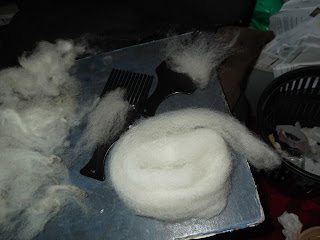The Long Draw
Sooner or later if using a drop spindle you will encounter something that is called the long draw. You know those videos where the spinner has one hand on the spindle and one hand on the wool and the thread seems to pull itself out of the wool without any assistance from the spinner? That is the long draw.
I even found instructions for it. Apparently you take your rolag, give it a bit of a twist, start spinning and then pull the wool away from the spindle and it pulls itself out of the rolag in your hand.
Like *** it does!!!
I finally received my Spindolyn a few weeks ago. A spindolyn is a modern take on the supported spindle. It's like a kebab skewer with a whorl and it sits in a thin tube. You spin it in the tube and it can't drop to the floor (unless you knock it over.) The idea is patented by the manufacturer, by the way, so don't go rushing off to make your own.
I was going to add a photo but Blogger is having trouble uploading it. Will try again later.
Anyhow.
The recommended method for the spindolyn is the long draw.
Oh
Dear!
Well on the positive side I have got further with it than I have with any drop spindle. Unfortunately I have totally failed to produce useable thread this way. I recommend sticking with pinch and pull unless and until you find someone to show you personally how to do the long draw.
The theory is that if you get the spin just right it will wind the fibres at the same rate that you are pulling the wool back and that pulls the yarn from the wool.
My experience is that it produces a much thinner and weaker yarn. I find that the yarn constantly breaks while I try to wind it ready for plying.
I wonder if this is the reason why there was a time when it was illegal to sell wool made with a spinning wheel? The long draw is used on wheels.
No, yes, I know that I may get better at it with time and practice, but as I would like to actually be able to USE the yarn I spin, I have had to revert to pinch and pull even with the Spindolyn. The yarn is thicker but it's stronger.
 |
| Spindolyn | |
At last! It uploaded.












